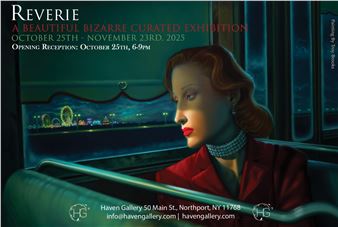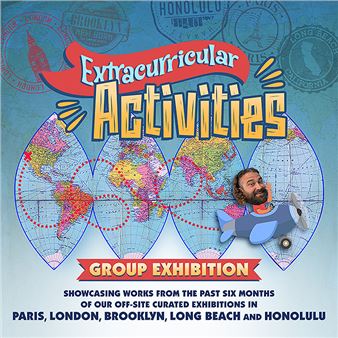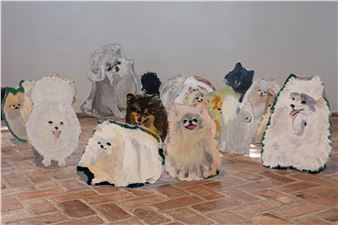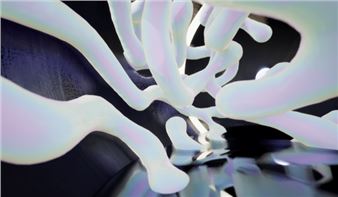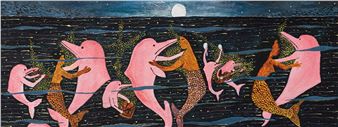Parham Ghalamdar: Painting, An Unending
HOME is delighted to present Painting, An Unending, a solo show of new work by artist Parham Ghalamdar, his largest institutional exhibition to date.
His work draws on traditions of Persian and Western art, graffiti, internet and digital culture. Elements abstracted from a range of personal and cultural references such as Piero de la FrancescaÔÇÖs fresco Dream of Constantine and objects from American cowboy cartoons, or sci-fi refences consumed during his childhood in Iran, are painted against bleak landscapes, creating often absurdly humorous epic scenes. Eschewing narrative, he approaches his work as a performer warming up their vocal cords, shape shifting colour with texture, surface quality and composition to infuse a dreamlike, surreal sensibility.
The tent featured in FrancescaÔÇÖs 15 Cent. fresco Dream of Constantine is used as a trope throughout Painting, An Unending. Located in a church in Arezzo, Italy, the fresco depicts the night before the Battle of Milvern Bridge, fought between the Roman Emperors Constantine and Maxentius. Historicised as the event that marked the death of paganism and the birth of Christianity as the dominant religion for the empire and Europe, the work symbolises a significant turning point in social, cultural and political consciousness. As such, for Ghalamdar, the work signifies a moment of pause, an ÔÇÿin between stateÔÇÖ, flickering between past and future, charged ambiguity or promise. Autobiographically, the work resonates as a state of transition, migration and shelter.
For Painting, An Unending, he has used an artificial intelligence tool that creates realistic images from text descriptions, as an extension of his sketchbook. Testing the AI generatorÔÇÖs capabilities in rendering the aesthetics of the classic mastersÔÇÖ into an image, he prompts it with social scenes or situations that due to his political beliefs or sexuality would be impossible in his homeland. The results appear surprising and random. Incorporating them into his work, he repaints and repeats the process endlessly. The work jumps from one epoch, or socio/political context, to another within the same canvas, exploring notions of identity politics, migration, freedom of movement, boarders, community and belonging.
The repetition and production of his work can be seen as a liberating process of catharsis; reconciliation or reckoning with his past, coming of age in an authoritarian regime. In a country where imported western culture was readily consumed, yet laws on the production of culture in Iran are consistently ambiguous, redefined or banned, Ghalamdar pushes the limitations of the medium of painting through AI image synthesis, navigating the tensions and traversing between self-expression and authorship; authenticity and censorship.
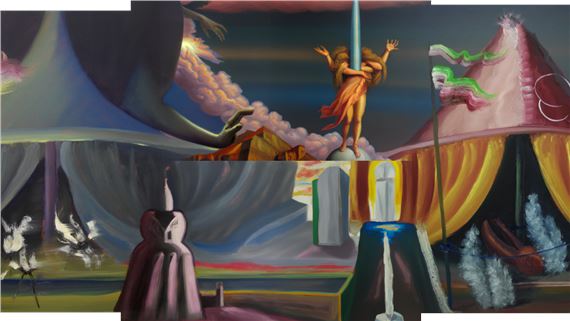
Recommended for you
HOME is delighted to present Painting, An Unending, a solo show of new work by artist Parham Ghalamdar, his largest institutional exhibition to date.
His work draws on traditions of Persian and Western art, graffiti, internet and digital culture. Elements abstracted from a range of personal and cultural references such as Piero de la FrancescaÔÇÖs fresco Dream of Constantine and objects from American cowboy cartoons, or sci-fi refences consumed during his childhood in Iran, are painted against bleak landscapes, creating often absurdly humorous epic scenes. Eschewing narrative, he approaches his work as a performer warming up their vocal cords, shape shifting colour with texture, surface quality and composition to infuse a dreamlike, surreal sensibility.
The tent featured in FrancescaÔÇÖs 15 Cent. fresco Dream of Constantine is used as a trope throughout Painting, An Unending. Located in a church in Arezzo, Italy, the fresco depicts the night before the Battle of Milvern Bridge, fought between the Roman Emperors Constantine and Maxentius. Historicised as the event that marked the death of paganism and the birth of Christianity as the dominant religion for the empire and Europe, the work symbolises a significant turning point in social, cultural and political consciousness. As such, for Ghalamdar, the work signifies a moment of pause, an ÔÇÿin between stateÔÇÖ, flickering between past and future, charged ambiguity or promise. Autobiographically, the work resonates as a state of transition, migration and shelter.
For Painting, An Unending, he has used an artificial intelligence tool that creates realistic images from text descriptions, as an extension of his sketchbook. Testing the AI generatorÔÇÖs capabilities in rendering the aesthetics of the classic mastersÔÇÖ into an image, he prompts it with social scenes or situations that due to his political beliefs or sexuality would be impossible in his homeland. The results appear surprising and random. Incorporating them into his work, he repaints and repeats the process endlessly. The work jumps from one epoch, or socio/political context, to another within the same canvas, exploring notions of identity politics, migration, freedom of movement, boarders, community and belonging.
The repetition and production of his work can be seen as a liberating process of catharsis; reconciliation or reckoning with his past, coming of age in an authoritarian regime. In a country where imported western culture was readily consumed, yet laws on the production of culture in Iran are consistently ambiguous, redefined or banned, Ghalamdar pushes the limitations of the medium of painting through AI image synthesis, navigating the tensions and traversing between self-expression and authorship; authenticity and censorship.

 ARTISTS
ARTISTS







